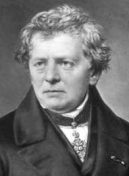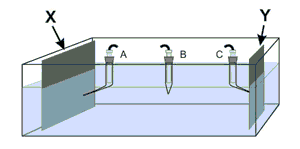Georg Simon Ohm (1787)

Source: Wikimedia Commons (Public Domain)
Georg Simon Ohm was born in 1787 in Germany. His father, Johann Wolfgang Ohm, was a locksmith and his mother, Maria Elizabeth Beck, was the daughter of a tailor. Although his parents had not been formally educated, Ohm's father was a remarkable man who had educated himself and was able to give his sons an excellent education through his own teachings.
In 1805, Ohm entered the University of Erlangen and received a doctorate. He wrote elementary geometry books while teaching mathematics at several schools. Ohm began experimental work in a school physics laboratory after he had learned of the discovery of electromagnetism in 1820.
In two important papers in 1826, Ohm gave a mathematical description of conduction in circuits modeled on Fourier's study of heat conduction. These papers continue Ohm's deduction of results from experimental evidence and, particularly in the second, he was able to propose laws which went a long way to explaining results of others working on galvanic electricity.
The basic components of an electrochemical cell are:

1) Electrodes (X and Y) that are made of electrically conductive materials:
metals, carbon, composites ...
2) Reference electrodes (A, B, C) that are in electrolytic contact with an electrolyte
3) The cell itself or container that is made of an inert material: glass, Plexiglass,
... and
4) An electrolyte that is the solution containing ions.
Using the results of his experiments, Georg Simon Ohm was able to define the fundamental relationship between voltage, current, and resistance. What is now known as Ohm's law appeared in his most famous work, a book published in 1827 that gave his complete theory of electricity.
The equation I = V/R is known as "Ohm’s Law". It states that the amount of steady current through a material is directly proportional to the voltage across the material divided by the electrical resistance of the material. The ohm (R), a unit of electrical resistance, is equal to that of a conductor in which a current (I) of one ampere is produced by a potential of one volt (V) across its terminals. These fundamental relationships represent the true beginning of electrical circuit analysis.


